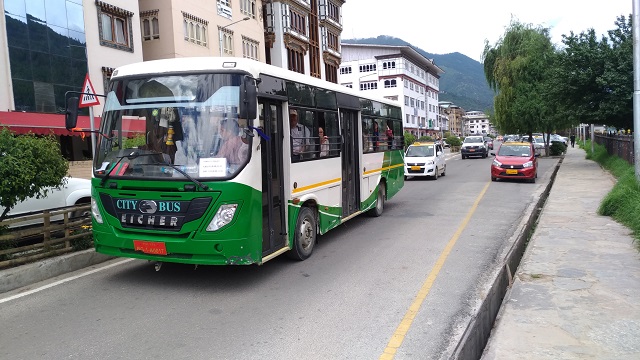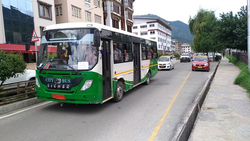ALP Presents Strategy for Pre-BRTs in Thimphu

The Asia LEDS Partnership (ALP) successfully conducted and presented an assessment of the existing public transport system and a strategy for a pre-Bus Rapid Transit system (BRTs) to strengthen the public transport system in Thimphu under its ongoing Swiss Agency for Development and Cooperation-funded project.
The assessment – part of the technical assistance provided to the Gross National Happiness Commission (GNHC), Royal Government of Bhutan – was presented at a meeting chaired by the Hon’ble Mayor of Thimphu. Among those who attended the meeting were key officials from government agencies such as Director-General, Road Safety Transport Authority; representatives from GNHC; traffic police; Ministry of Information and Communication; Thimphu City Bus Service; and the planning department, Thimphu City.
The project team had made a four-day visit to Thimphu City earlier to assess the public transport system. The team interacted closely with the city government and other stakeholders in the urban mobility and public transport sectors to assess the situation and to develop a deeper understanding of the issues, barriers and opportunities related to public transport in Thimphu. Based on the initial assessment and scoping, the city mayor requested the project team to develop a pre-BRTs strategy and action plan that could be the foundation for preparing a planned BRTs in the city.

The project team conducted traffic surveys from the 1st to the 7th of October 2019 to develop a strategy for safe, reliable, affordable and convenient, besides cost-effective and environment-friendly pre-BRTs. The surveys included studying the classified traffic volume counts (CVC) along eight cordon points in the city, and origin-destination (OD) surveys for seven days from 7am to 7pm.
The CVC surveys involved 16 surveyors who recorded the number of vehicles passing on pre-determined locations, using tally marks in inventories. Raw data from those inventories were then organised for compilation and analysis. The CVC helped the team to identify the hourly distribution of vehicles, peak hours and level of service, and compare modal composition on different hierarchy of roads. The same data was used to provide possible solutions and suggestions for improvement of public transport as part of the pre-BRTs. Elaborate OD surveys were conducted to understand the travel patterns of the people of Thimphu. OD data constitutes the most important dataset for urban transport planning. Using raw data, a reasonable OD matrix was developed, which helped to identify emerging nodes where more dynamic transport demand existed.

Based on the survey data assessment, the ALP team formulated and presented a detailed strategy for a pre-BRTs to strengthen the public transport system. The detailed strategy presented to government officials included identification of the most feasible rational routes for a pre-BRTS, a trunk and feeder system for increased frequency of service, faster service and grade separation (priority bus lanes), besides standardisation of bus specification for improved comfort, bus shelters and a passenger information system. The team also stressed on various pre-requisites for a successful pre-BRTs, such as a policy framework, travel demand management strategies, public transport planning and necessary traffic engineering improvements. Ongoing initiatives by the Thimphu Thromde to organise private vehicle parking, develop new bus terminals and procure more busses were also included in the key considerations in the strategy recommendations.
The scoping and strategy for the pre-BRTs in Thimphu was appreciated by the officials present at the meeting, who requested the project team to share the same with the GNHC.



